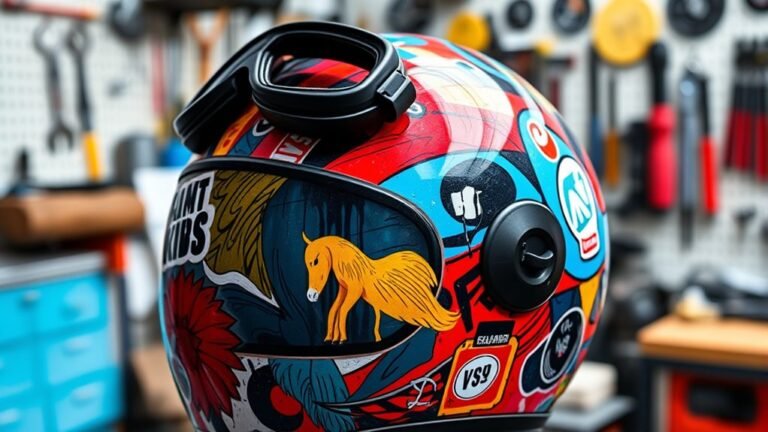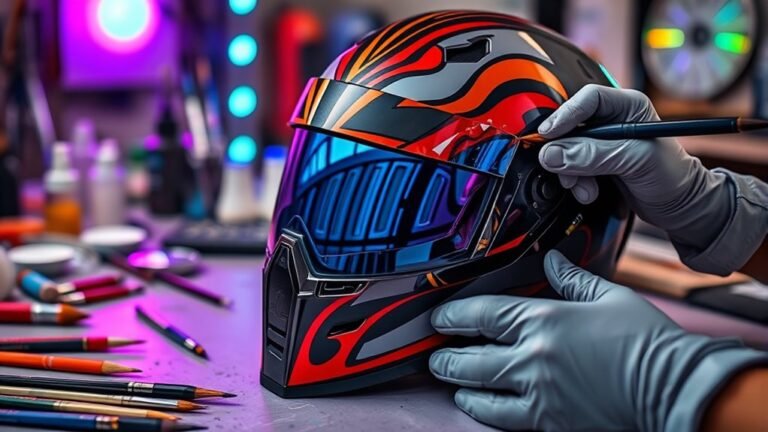Best Tutorials for Beginners in Helmet Making
If you’re new to helmet making, start by gathering essential tools like a cutting knife and heat gun. Look for beginner tutorials on platforms like YouTube or online courses that walk you through step-by-step processes. These resources will guide you in shaping, layering, and painting your helmet. Don’t forget about safety standards to guarantee your helmet is reliable. Keep exploring for advanced techniques and design tips that’ll elevate your helmet-making skills even further.
Essential Tools and Materials for Helmet Making

When you’re getting started with helmet making, having the right tools and materials can make all the difference. First, gather essential tools like a sturdy cutting knife for shaping, a heat gun for molding, and sandpaper for smoothing edges. You’ll also need a strong adhesive to bond your helmet components securely. For helmet materials, consider lightweight foam or fiberglass for structure, and a durable outer shell for protection. Don’t forget to include padding for comfort inside the helmet. With these tools and materials in hand, you’ll be well on your way to creating a helmet that not only looks great but also provides the protection you need. Embrace your creativity, and enjoy the freedom of crafting your unique design!
Step-by-Step Guide to Crafting a Basic Helmet

Before diving into the crafting process, it’s essential to have a clear plan in mind for your basic helmet design. Start by sketching your ideas, considering shape and size. Gather your materials, like foam or fiberglass, depending on your preferred helmet crafting techniques. Cut the base shape of your helmet carefully, ensuring it fits snugly. Next, create layers for added protection, and attach them using strong adhesive. Don’t forget to add ventilation holes for comfort! Once everything’s assembled, sand the edges for a smooth finish. Finally, paint your helmet with your choice of colors, letting your creativity shine. Following these steps, you’ll be well on your way to crafting a functional and stylish basic helmet. Enjoy the freedom of making something uniquely yours!
Advanced Techniques for Custom Designs

As you venture into advanced techniques for custom helmet designs, you’ll discover a world of possibilities that allow for greater creativity and personalization. One exciting avenue is custom paint; experimenting with different colors and finishes can truly make your helmet stand out. Don’t be afraid to play with textures and patterns, using airbrush techniques or decals for unique effects.
Additionally, design software can be a game-changer. Programs like Adobe Illustrator or Procreate let you visualize your ideas before committing. You can create intricate designs and layouts that reflect your style. With these tools at your disposal, you’ll not only enhance your skills but also guarantee your helmet is a true representation of your personality. Embrace the freedom to innovate!
Safety Standards and Testing Your Helmet
Although creating a custom helmet is an exciting journey, ensuring its safety is paramount. You need to familiarize yourself with helmet safety standards, which vary by region and type of activity. Look for certifications like DOT, ECE, or Snell, as these indicate that your helmet meets vital safety criteria.
Once your helmet’s built, testing methods become essential. You can perform basic impact tests by dropping weights onto it from various heights to see how well it absorbs shock. For more advanced testing, consider reaching out to local facilities that specialize in helmet testing. Remember, a safe helmet not only protects you but also allows you to ride freely, knowing you’ve prioritized your well-being. So, take these steps seriously!
Resources for Further Learning and Inspiration
Whether you’re just starting out or looking to refine your skills, there are plenty of resources available to help you dive deeper into helmet making. Explore these options to ignite your passion for helmet design:
- Online Courses: Websites like Skillshare and Udemy offer structured lessons tailored for beginners, covering everything from materials to crafting techniques.
- YouTube Channels: Channels dedicated to DIY projects often have tutorials focusing on helmet making, showcasing different styles and methods.
- Forums and Communities: Joining online forums or social media groups can connect you with fellow enthusiasts who share tips, inspiration, and feedback.
These resources can empower you to experiment and evolve your helmet-making journey. Embrace the process and let your creativity flow!
Frequently Asked Questions
How Long Does It Take to Make a Helmet?
It typically takes anywhere from a few hours to several days to make a helmet, depending on your skills and the complexity of the design. For beginners, helmet crafting can be a fun yet challenging process, so don’t rush it. Embrace the production timeline as part of your learning journey. Each step enhances your skills and creativity, giving you the freedom to express yourself while creating something functional and unique. Enjoy the process!
Can I Use Recycled Materials for Helmet Making?
Absolutely, you can use recycled materials for helmet making! Think of it as crafting a shield from the remnants of your past adventures. Just guarantee that whatever materials you choose meet safety standards, as helmet safety is paramount. With a little creativity, you can transform everyday items into something protective and unique. So, embrace those recycled materials, and let your freedom of expression shine through your helmet’s design while keeping safety in mind!
What Are Common Mistakes to Avoid in Helmet Making?
When you’re making helmets, avoid common errors like neglecting safety precautions or using inappropriate materials. Always guarantee your helmet meets safety standards; it’s essential for protection. Don’t rush the fitting process; a poorly fitted helmet won’t provide adequate safety. Also, skip shortcuts in construction—taking time to follow each step carefully will yield better results. Embrace the freedom of creativity, but prioritize safety and quality for the best helmet-making experience!
Is There a Recommended Age for Beginners in Helmet Making?
There’s no strict age limit for helmet making, but age guidelines suggest it’s best for those around 12 and up, who can grasp safety concepts. You’ll find making helmets an exciting journey, like crafting your own shield in a world of imagination. Just remember to prioritize beginner safety—using the right tools and materials can make a world of difference. Embrace your creativity, and let your passion for helmet making soar!
Can I Sell Helmets I Make for Personal Use?
Yes, you can sell helmets you make for personal use, but you’ll need to check the legal requirements in your area. Different places have specific selling guidelines, especially for safety gear like helmets. It’s crucial to guarantee your products meet safety standards to protect both you and your customers. Don’t let these requirements discourage you; with the right knowledge, you can create and sell helmets that others will love.






